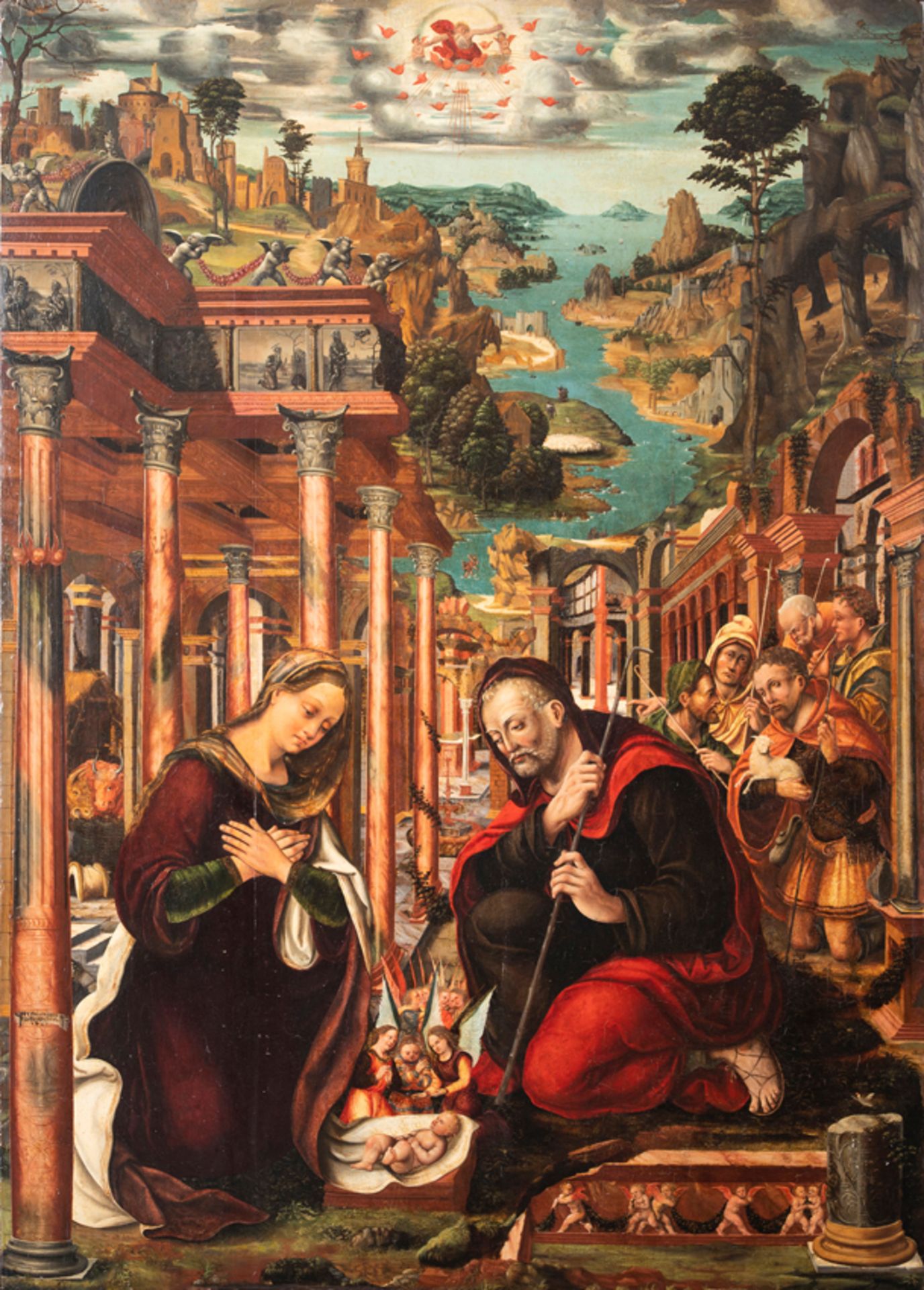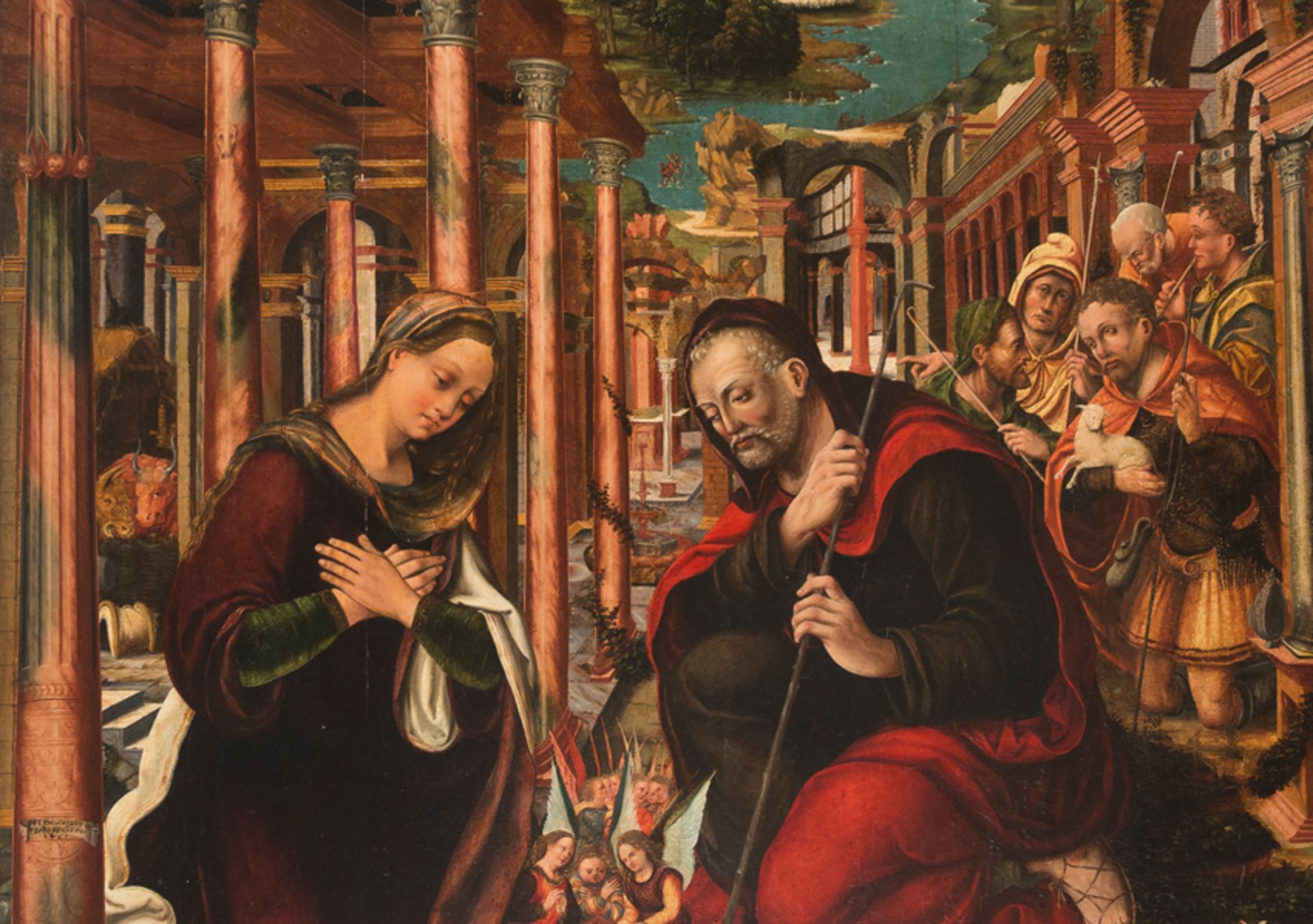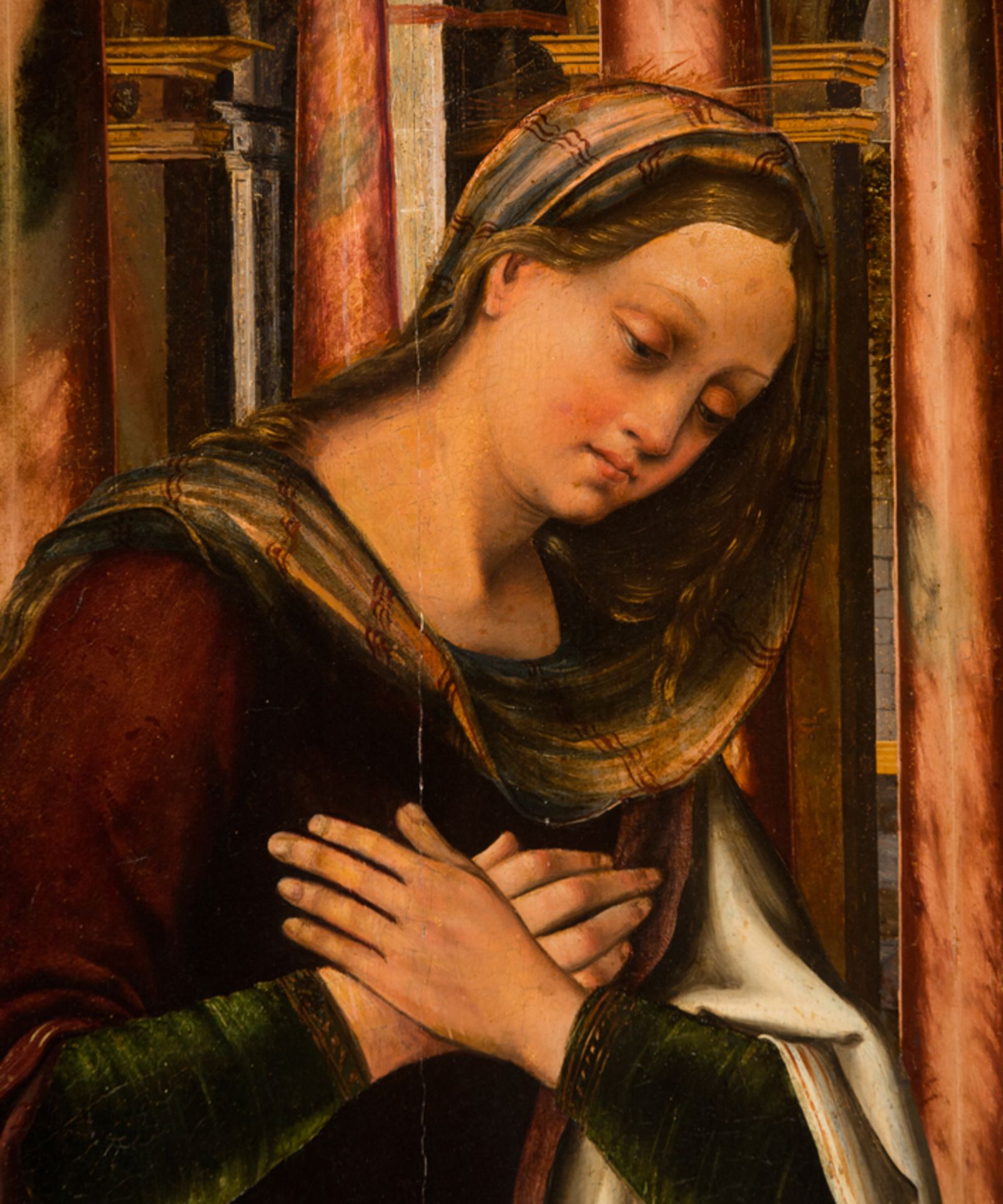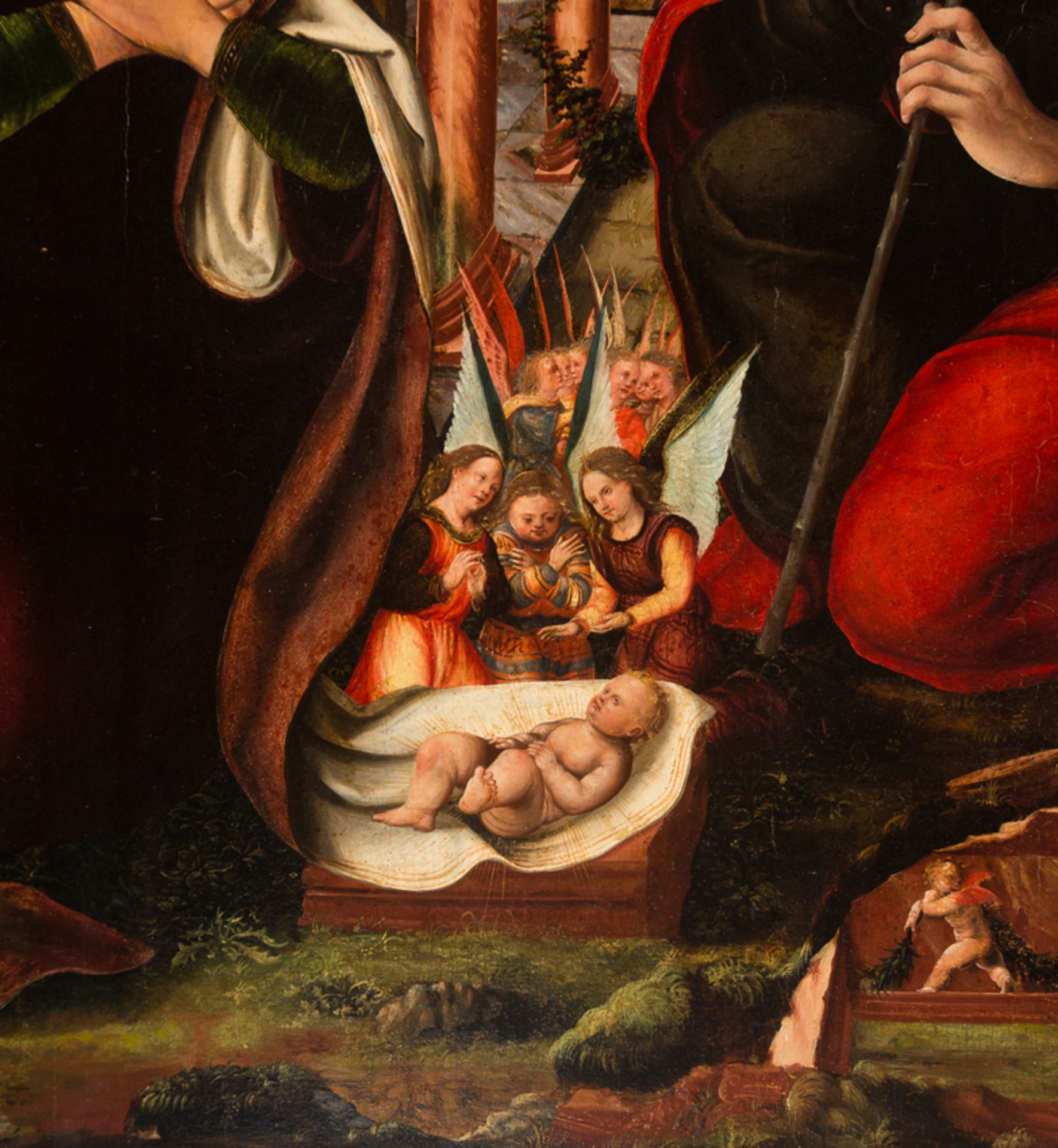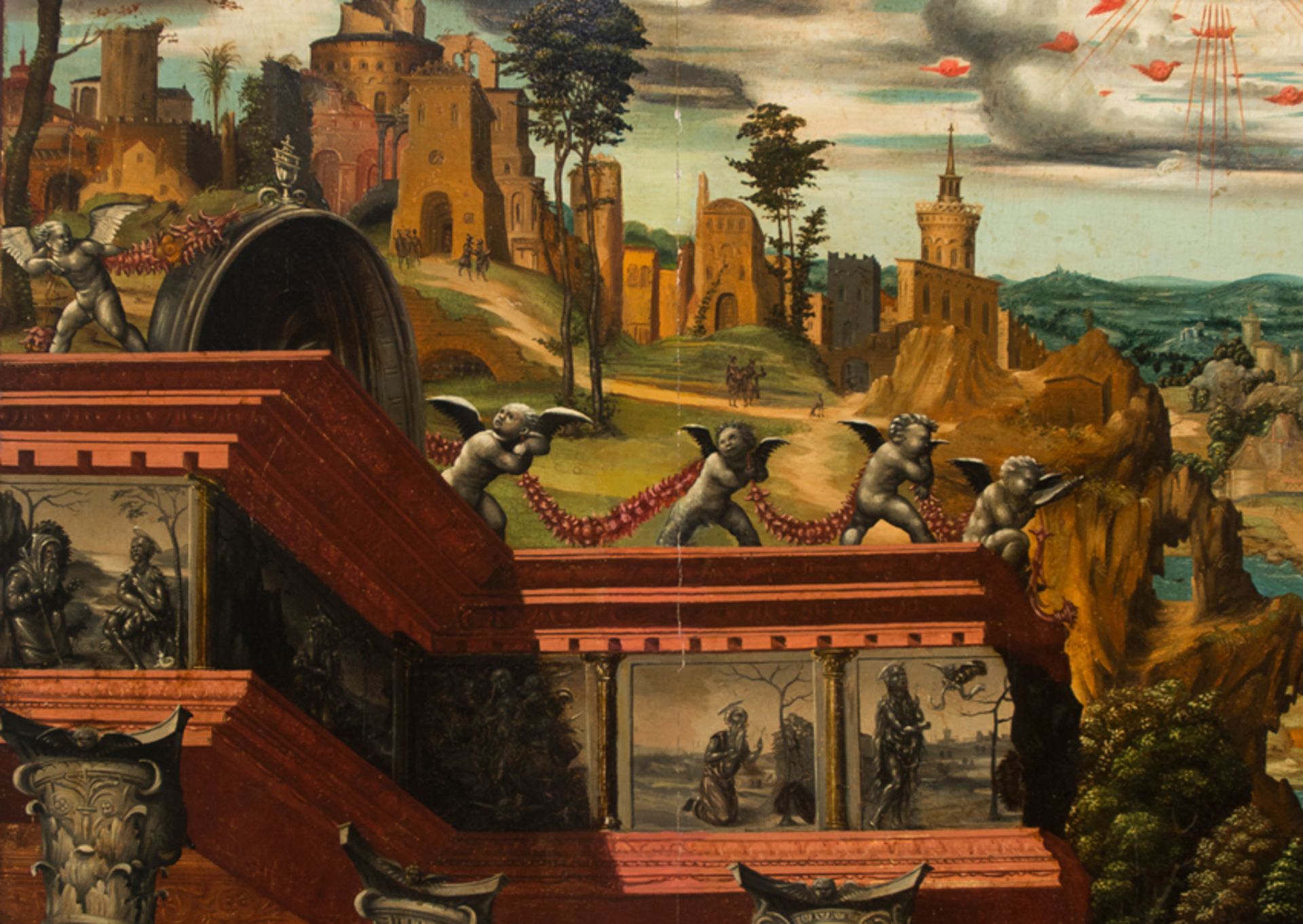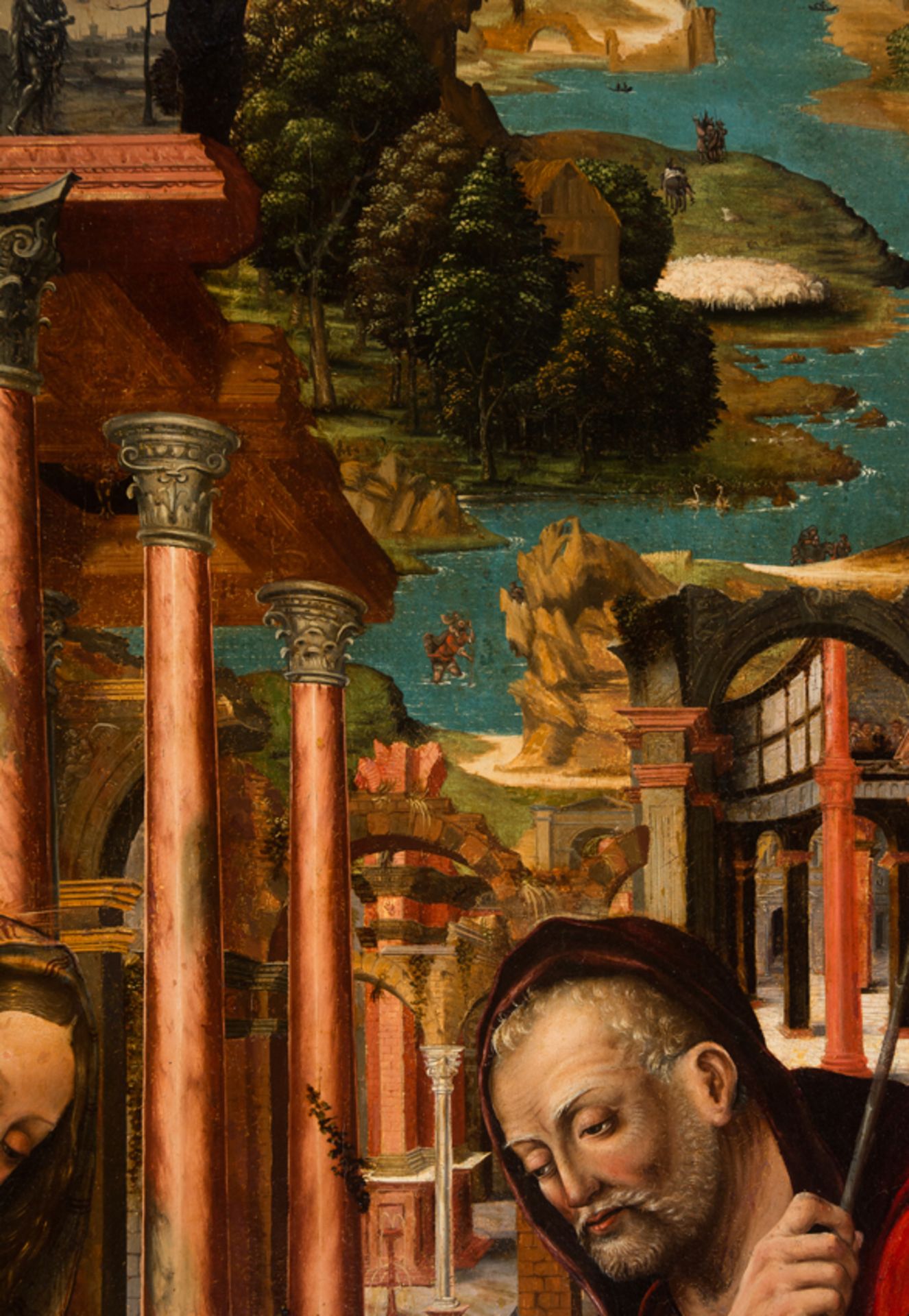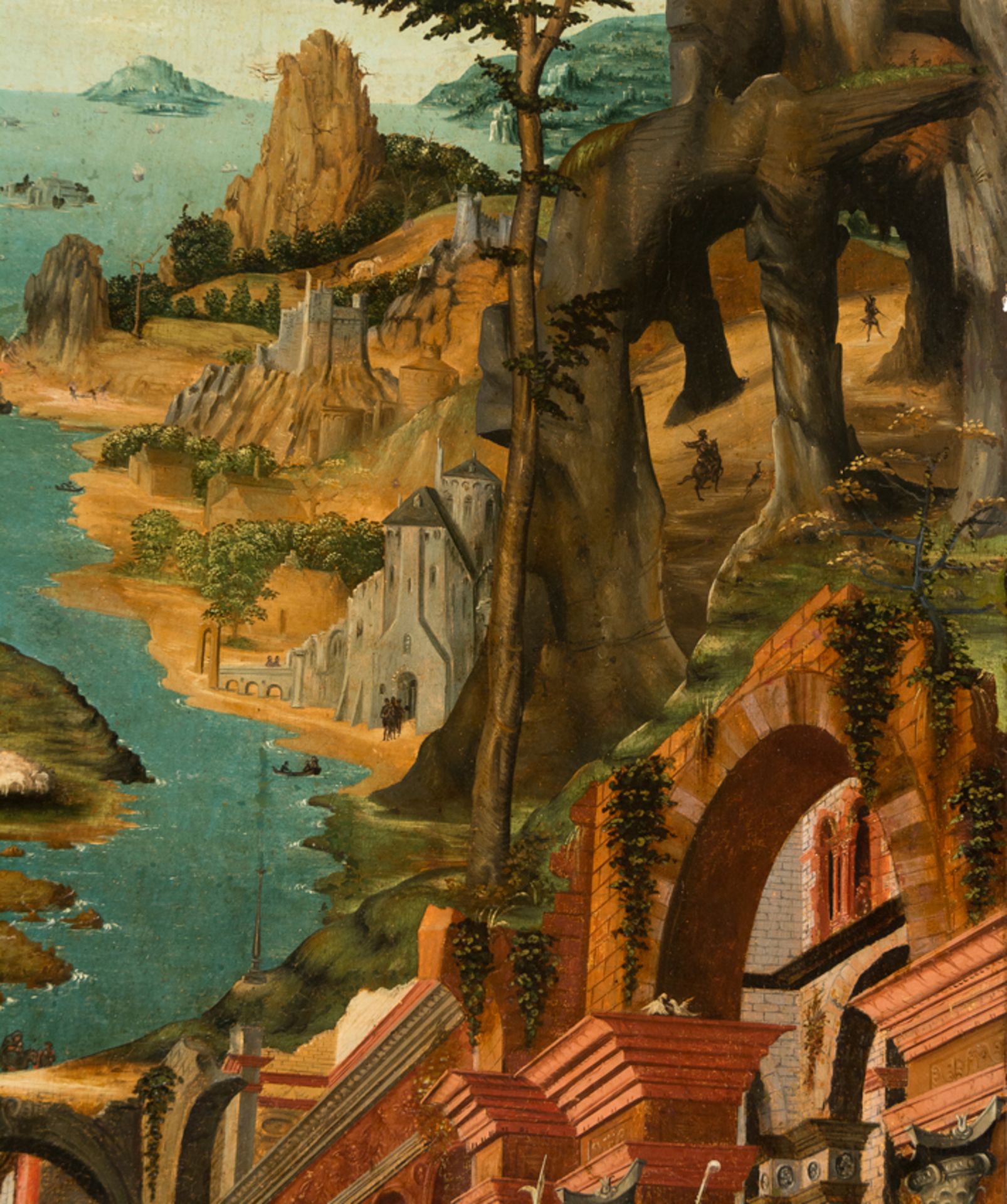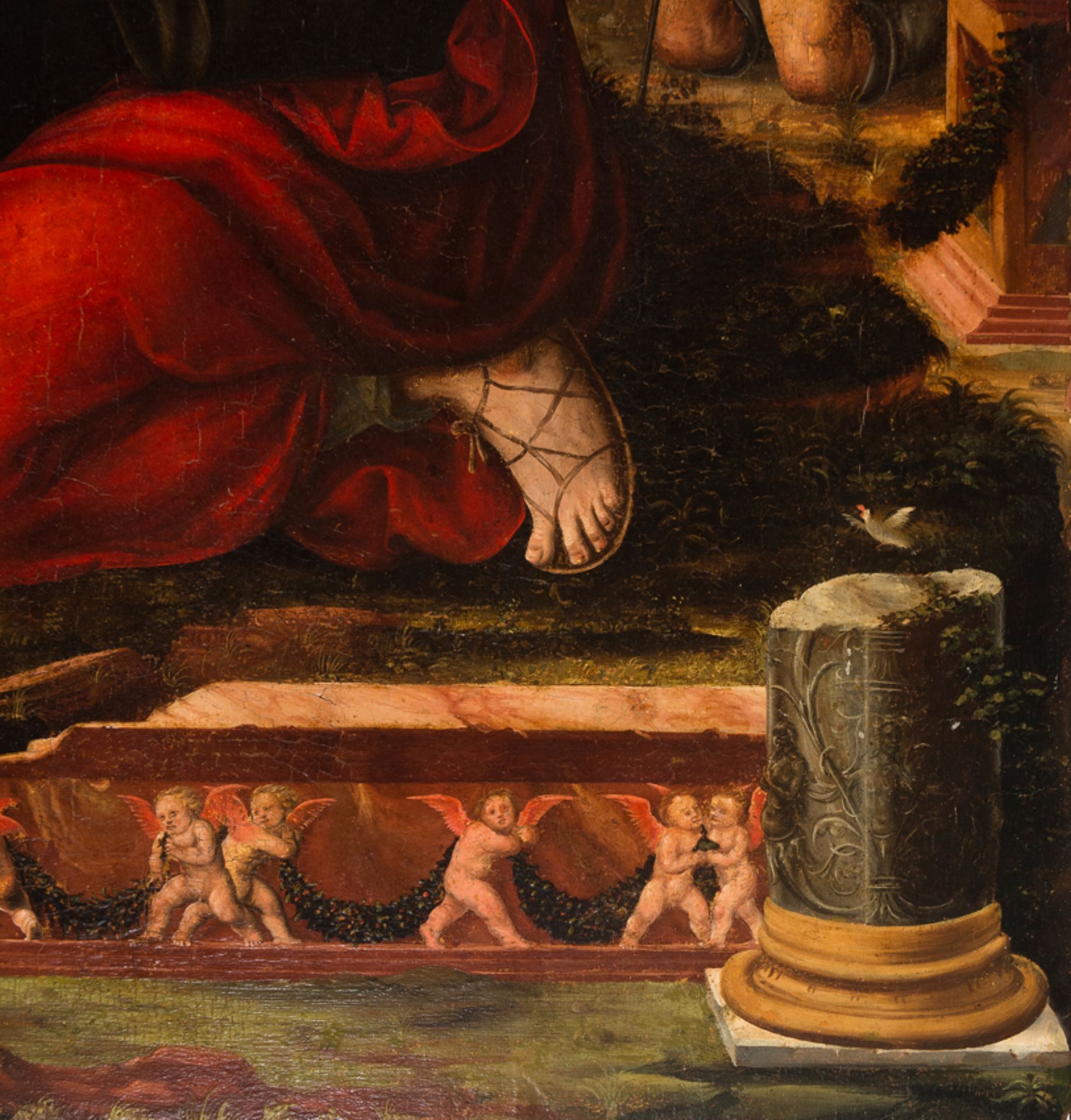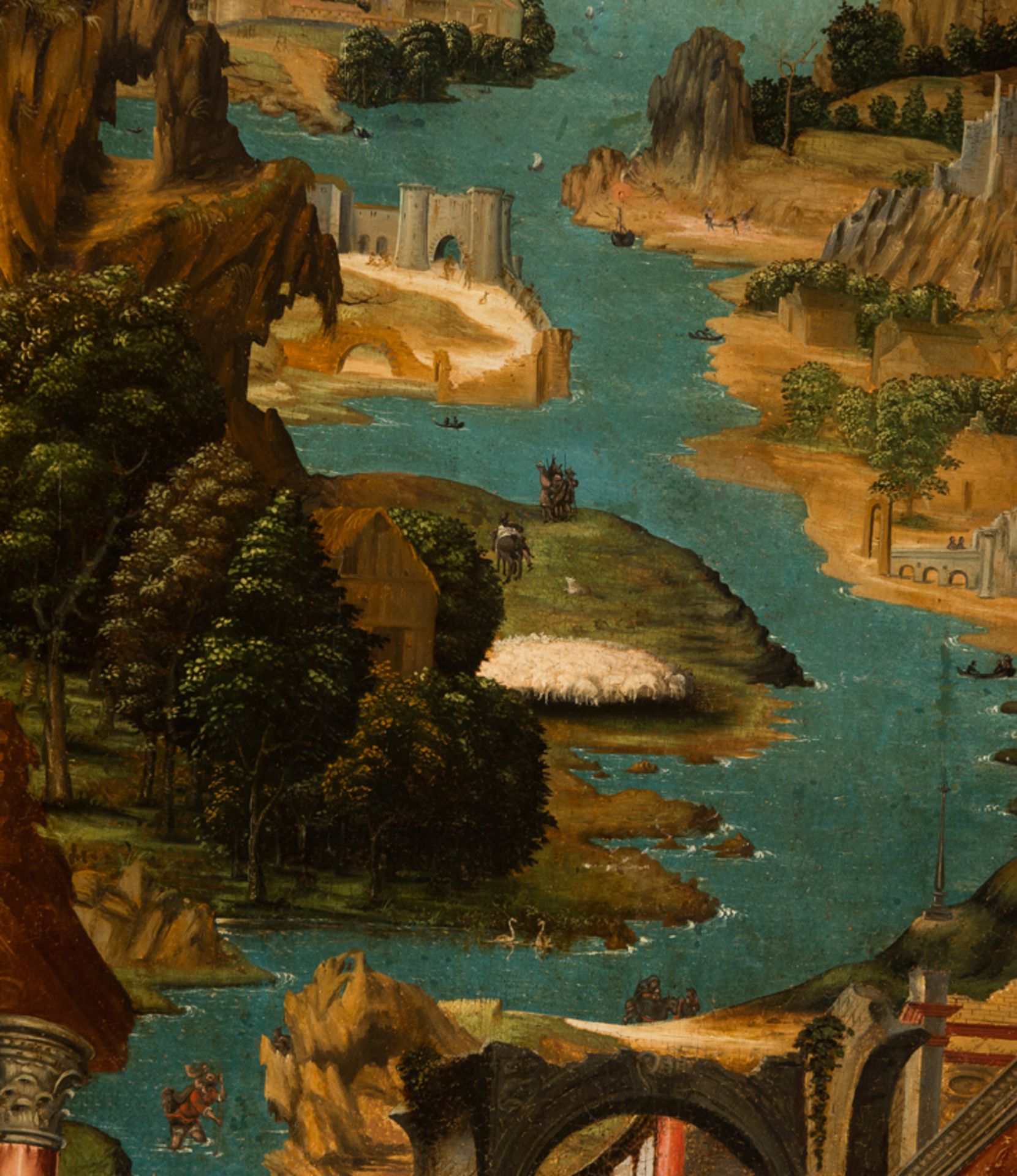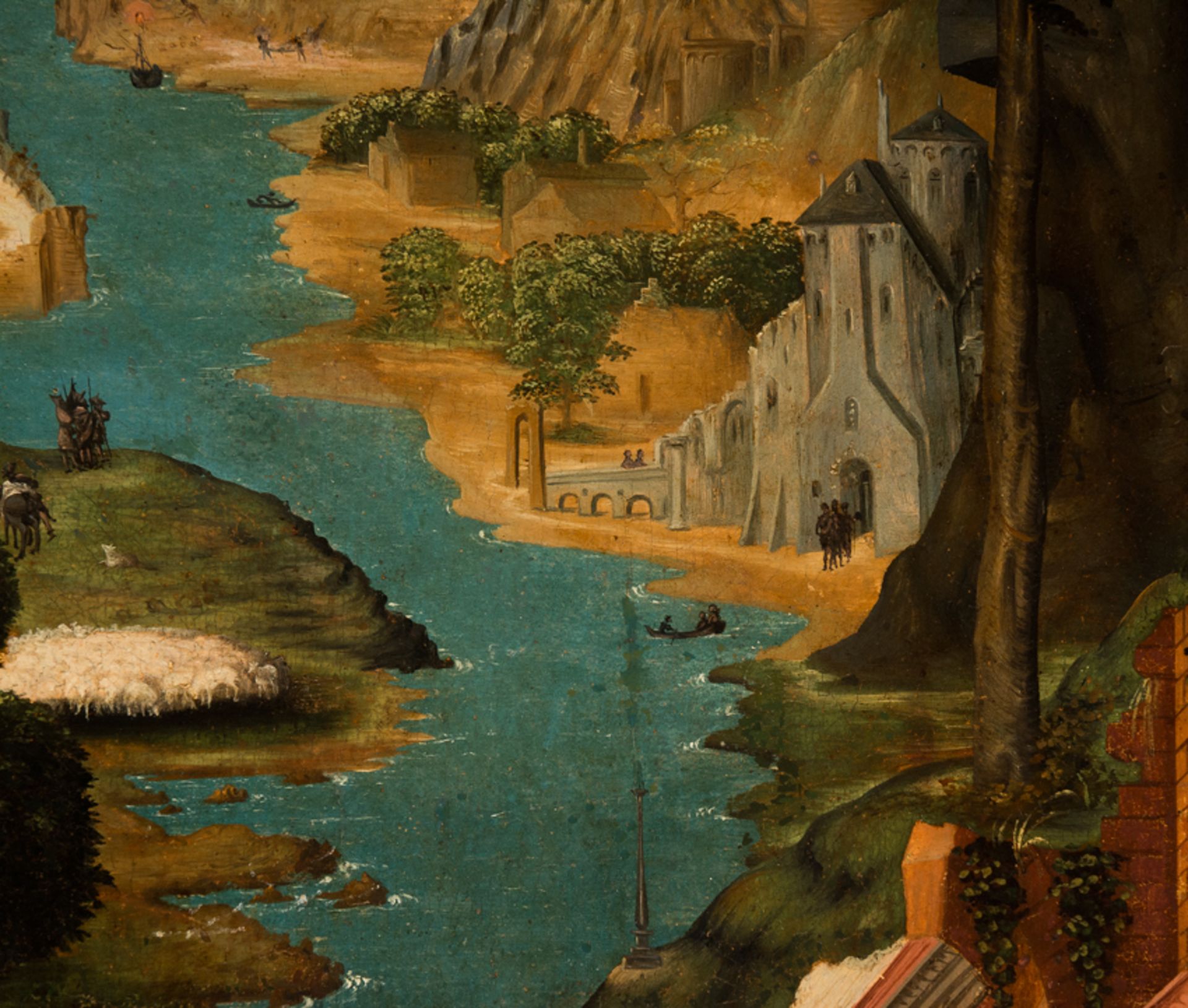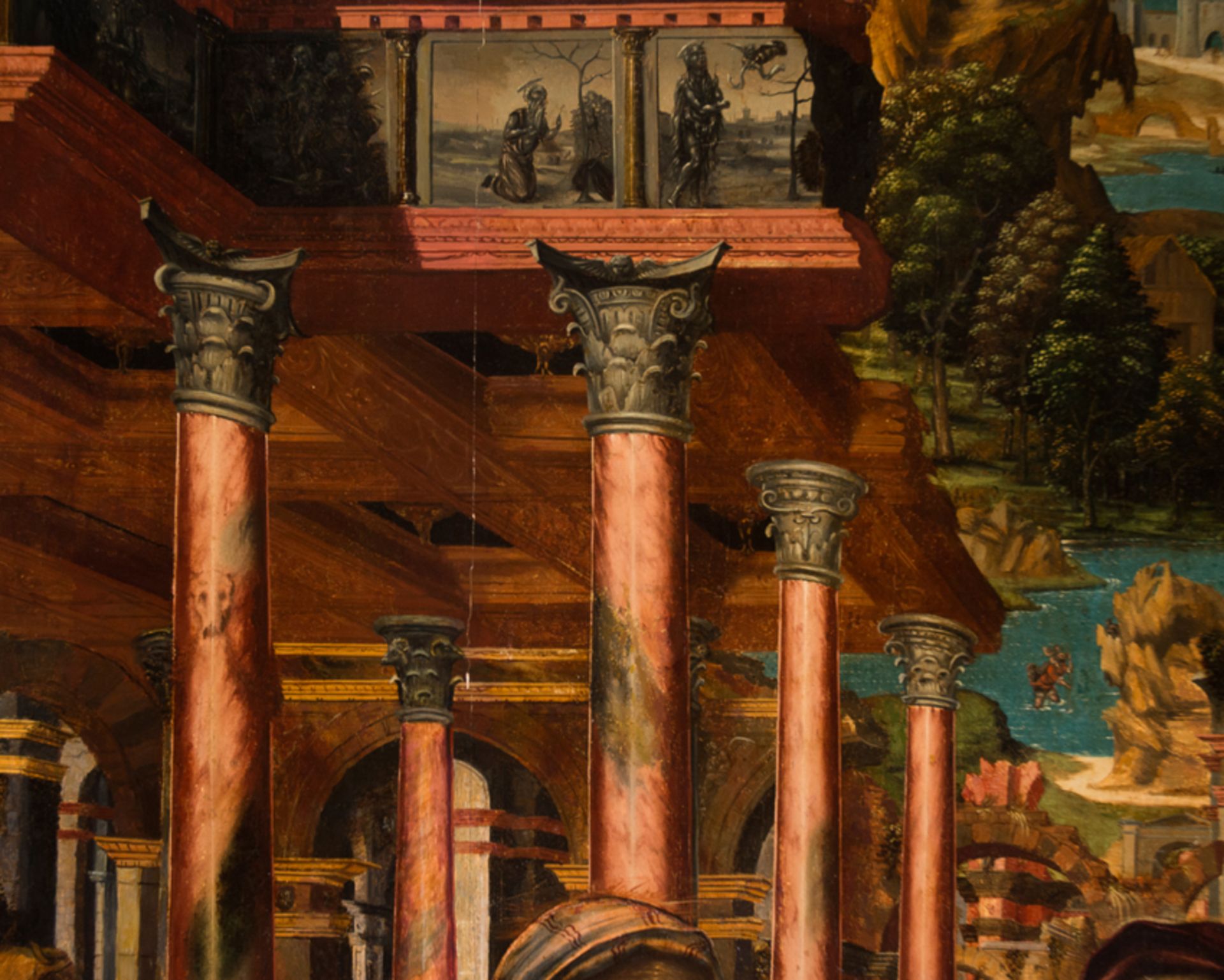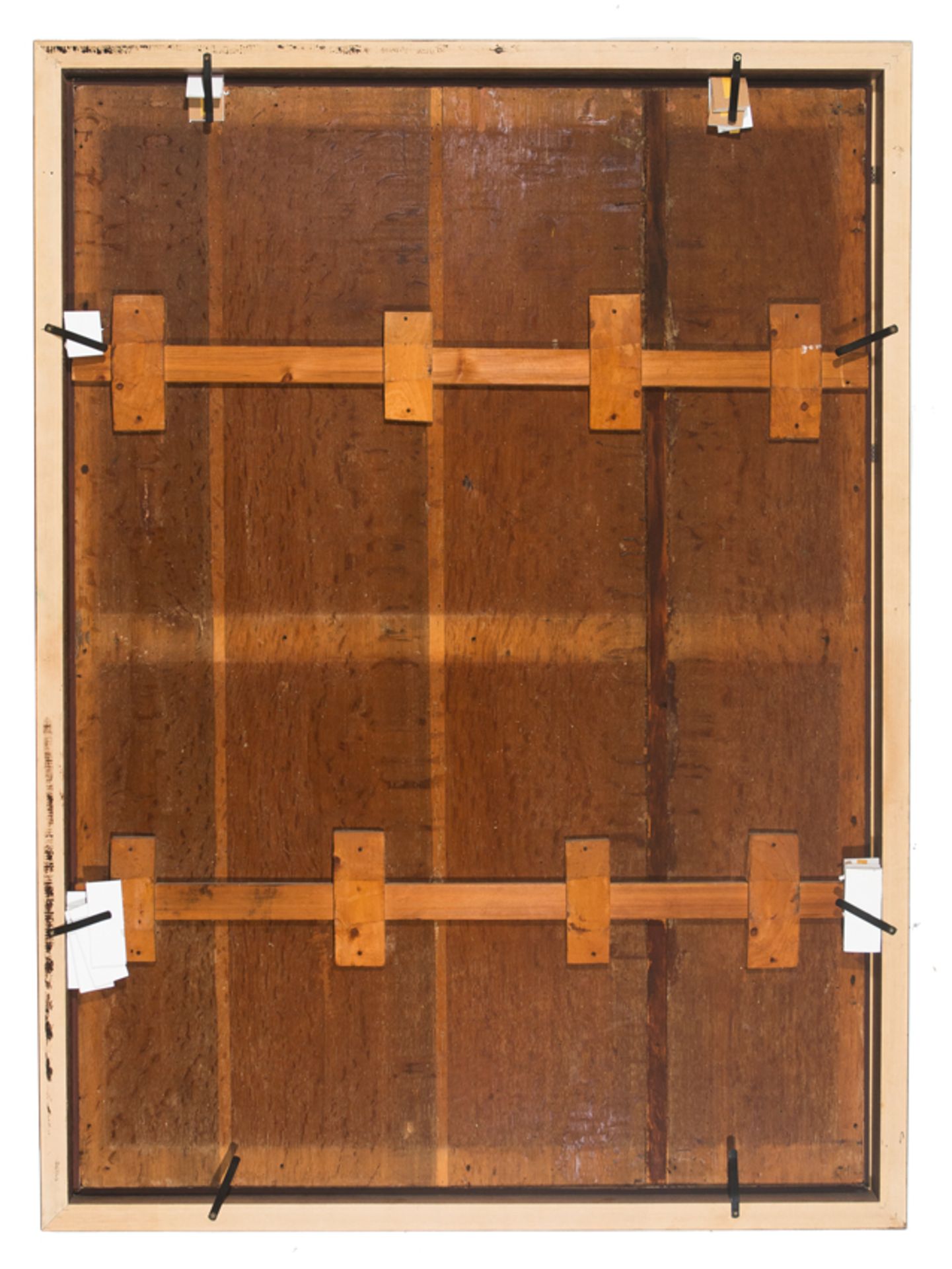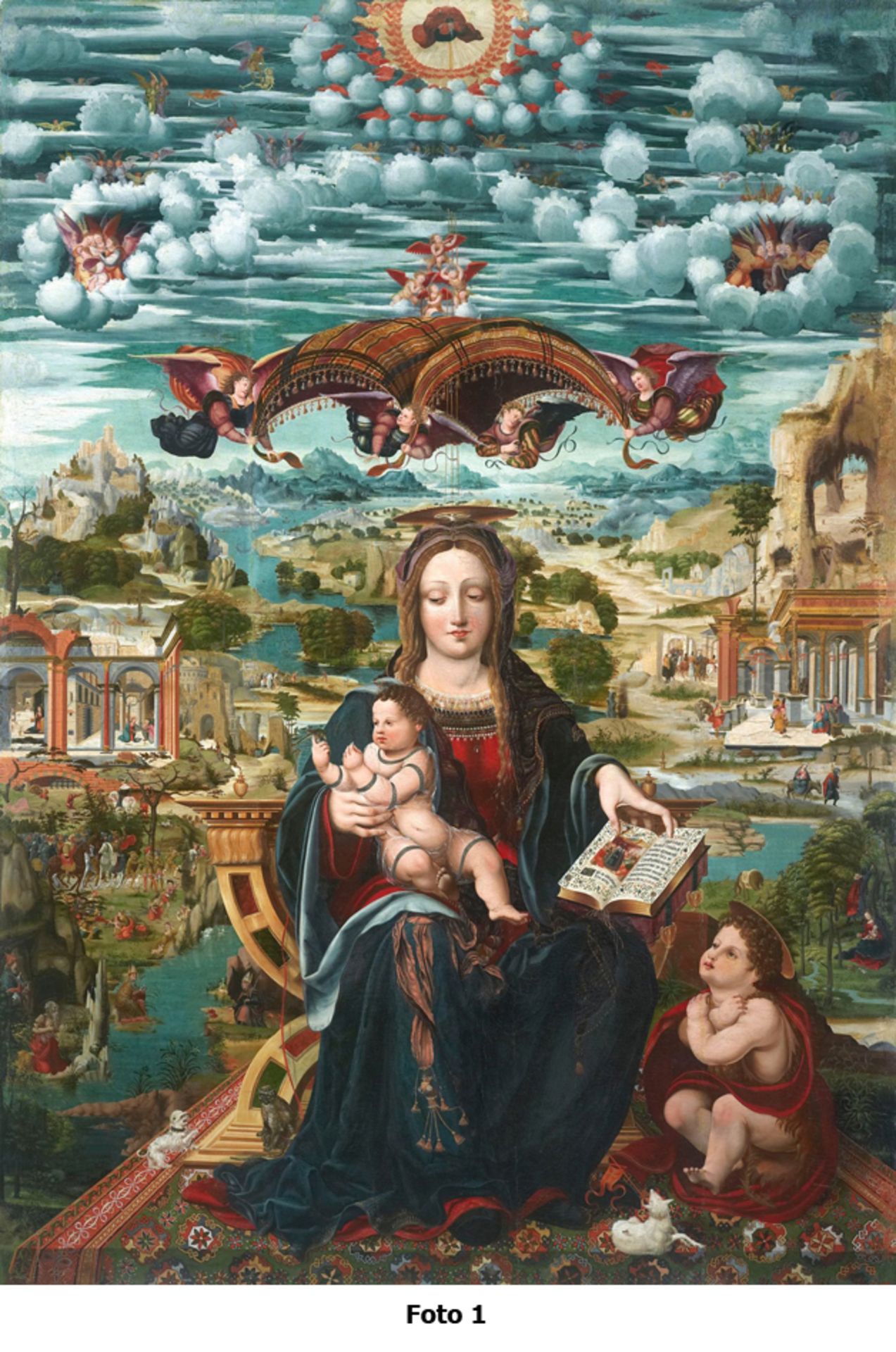11
Joan de Borgonya (doc. 1496-1525)
Joan de Borgonya (doc. 1496-1525)
"The Nativity"
Oil on oak panel. Circa 1485-1505. 129 x 91 cm.
According to the report written by Dr. Alberto Velasco Gonzàlez, this work is one of the most important examples of Renaissance painting of the Crown of Aragon to have come to light in recent years. It is a previously unknown compartment from an altarpiece depicting the Nativity, which must be attributed to the painter Joan de Borgonya, one of the most representative masters of painting from Catalonia in the first quarter of the 16th century. The painting is highly dramatic due to the treatment of the perspective, the richness of the details and the complex classicist design of the architecture depicted. It should be included in the catalogue of the painter's work and also be considered one of his highest quality paintings.
The classical-style architecture in the form of a symbolic ruin, which occupies a large part of the pictorial surface of the panel and takes a central role in the composition, is outstanding. The painter has depicted a true architectural forest of columns, entablatures and truncated pilasters that make up a labyrinth that aims to show dynamic structures that guide the viewer to the landscape in the background, and does so from the diagonals that are traced by the cornices positioned at the mid-height of the composition. It is an exercise in skill which has a dramatic and effective result. This special and unmistakable treatment is one of the aspects that is most decisive in attributing the painting to Joan de Borgonya, since it reappears in an identical manner in other of his works, such as the iconic Our Lady with the Monkey in the Museu Nacional d'Art de Catalunya (Foto 1), or in an Annunciation recently acquired by the Generalitat de Catalunya and kept at the aforementioned Catalan museum.
The landscape takes on the appearance of a river bay represented with attention to detail and meticulousness, including isolated depictions of characters and episodes that give meaning and substance to the painting. Joan de Borgonya revels in this narrative complexity and in this type of detail in his peopled landscapes, which ends up becoming one of the most particular aspects of his art.
Another aspect to highlight is that the work was painted on oak wood, just the same material that was used in the aforementioned paintings in the MNAC museum in Barcelona. This is not a trivial detail, since Joan de Borgonya was a master of Nordic origin who must have felt comfortable with this material and continued to use it after his arrival in Valencia, where he lived between the end of the 15th century and the beginning of the 16th. From his years in Valencia, only the six panels of the Altarpiece of Saint Andrew painted for the church of Miracle in Valencia are preserved. They are currently kept in the cathedral and in a private collection. Around 1508-1509 the painter had to leave Valencia and moved to Catalonia, where he produced works such as the Altarpiece of the Magdalena of the monastery of Santes Creus (Tarragona), and the missing main altarpiece of Santa María del Pi (Barcelona), which has now disappeared. We must also mention the altarpiece dedicated to Saint Sebastian for the town of Sitges, which is not preserved; various works for the Lleida town of Bellpuig, where two panels with Saint Gregory the Great and Saint Jerome are kept; the polychrome of the backrests of the choir of the cathedral of Barcelona on the occasion of the celebration of the 19th meeting of the Order of the Golden Fleece; the main altarpiece of the church of San Félix in Girona, of which a series of compartments are kept in the Museu d'Art de Girona; the Altarpiece of Santa Úrsula for Girona Cathedral, of which the main panel is kept in the Girona Museum; and the altarpieces for the towns of Horta de Sant Joan (Tarragona) and Arenys de Lledó (Teruel), of which some panels from the latter remain. The painter must have died circa 1526.
Dr. Alberto Velasco Gonzàlez's report is attached.
Origin: private collection.
Bibliography on the painting: This painting was unknown until recently.
Bibliography on the painter:
- Adele Condorelli, “Un ritratto firmato: Opus Johanes Burgundi”, Commentari, 16, 196, pp. 77-84.
- Nicole Dacos, “Federico Zeri et l’excentrique. Joan de Burgunya en Italie”, Gazette des Beaux-Arts, CXXXV, 2000, pp. 109-116.
- Joaquim Garriga, “Biogr. 1. Joan de Borgonya. Notícies 1503-1525 (†)”, Joan Bosch and Joaquim Garriga (dirs.), De Flandes a Itàlia. El canvi de model en la pintura catalana del segle XVI: el bisbat de Girona, Girona, Museu d’Art de Girona, 1998, pp. 175-177.
- Joaquim Garriga, “Joan de Borgonya, pintor del XIXº capítulo de la orden del Toisón de Oro”, E. Belenguer Cebrià (coord.), De la unión de coronas al imperio de Carlos V. Congreso Internacional, Madrid, Sociedad Estatal para la Conmemoración de los Centenarios de Felipe II y Carlos V, 2001, vol. 3, pp. 121-180.
Joan Hilari Muñoz, “El pintor Joan de Borgonya al bisbat de Tortosa: els retaules d’Horta de Sant Joan i Arenys de Lledó”, Boletín de la Sociedad Castellonense de Cultura, LXXXII, 2006, pp. 307-321.
This lot has been declared "Bien de Interés Cultural (BIC)" (Good of Cultural Interest) by the Spanish Ministry of Culture, therefore we inform you that it is not allowed to be exported.
Joan de Borgonya (doc. 1496-1525)
"The Nativity"
Oil on oak panel. Circa 1485-1505. 129 x 91 cm.
According to the report written by Dr. Alberto Velasco Gonzàlez, this work is one of the most important examples of Renaissance painting of the Crown of Aragon to have come to light in recent years. It is a previously unknown compartment from an altarpiece depicting the Nativity, which must be attributed to the painter Joan de Borgonya, one of the most representative masters of painting from Catalonia in the first quarter of the 16th century. The painting is highly dramatic due to the treatment of the perspective, the richness of the details and the complex classicist design of the architecture depicted. It should be included in the catalogue of the painter's work and also be considered one of his highest quality paintings.
The classical-style architecture in the form of a symbolic ruin, which occupies a large part of the pictorial surface of the panel and takes a central role in the composition, is outstanding. The painter has depicted a true architectural forest of columns, entablatures and truncated pilasters that make up a labyrinth that aims to show dynamic structures that guide the viewer to the landscape in the background, and does so from the diagonals that are traced by the cornices positioned at the mid-height of the composition. It is an exercise in skill which has a dramatic and effective result. This special and unmistakable treatment is one of the aspects that is most decisive in attributing the painting to Joan de Borgonya, since it reappears in an identical manner in other of his works, such as the iconic Our Lady with the Monkey in the Museu Nacional d'Art de Catalunya (Foto 1), or in an Annunciation recently acquired by the Generalitat de Catalunya and kept at the aforementioned Catalan museum.
The landscape takes on the appearance of a river bay represented with attention to detail and meticulousness, including isolated depictions of characters and episodes that give meaning and substance to the painting. Joan de Borgonya revels in this narrative complexity and in this type of detail in his peopled landscapes, which ends up becoming one of the most particular aspects of his art.
Another aspect to highlight is that the work was painted on oak wood, just the same material that was used in the aforementioned paintings in the MNAC museum in Barcelona. This is not a trivial detail, since Joan de Borgonya was a master of Nordic origin who must have felt comfortable with this material and continued to use it after his arrival in Valencia, where he lived between the end of the 15th century and the beginning of the 16th. From his years in Valencia, only the six panels of the Altarpiece of Saint Andrew painted for the church of Miracle in Valencia are preserved. They are currently kept in the cathedral and in a private collection. Around 1508-1509 the painter had to leave Valencia and moved to Catalonia, where he produced works such as the Altarpiece of the Magdalena of the monastery of Santes Creus (Tarragona), and the missing main altarpiece of Santa María del Pi (Barcelona), which has now disappeared. We must also mention the altarpiece dedicated to Saint Sebastian for the town of Sitges, which is not preserved; various works for the Lleida town of Bellpuig, where two panels with Saint Gregory the Great and Saint Jerome are kept; the polychrome of the backrests of the choir of the cathedral of Barcelona on the occasion of the celebration of the 19th meeting of the Order of the Golden Fleece; the main altarpiece of the church of San Félix in Girona, of which a series of compartments are kept in the Museu d'Art de Girona; the Altarpiece of Santa Úrsula for Girona Cathedral, of which the main panel is kept in the Girona Museum; and the altarpieces for the towns of Horta de Sant Joan (Tarragona) and Arenys de Lledó (Teruel), of which some panels from the latter remain. The painter must have died circa 1526.
Dr. Alberto Velasco Gonzàlez's report is attached.
Origin: private collection.
Bibliography on the painting: This painting was unknown until recently.
Bibliography on the painter:
- Adele Condorelli, “Un ritratto firmato: Opus Johanes Burgundi”, Commentari, 16, 196, pp. 77-84.
- Nicole Dacos, “Federico Zeri et l’excentrique. Joan de Burgunya en Italie”, Gazette des Beaux-Arts, CXXXV, 2000, pp. 109-116.
- Joaquim Garriga, “Biogr. 1. Joan de Borgonya. Notícies 1503-1525 (†)”, Joan Bosch and Joaquim Garriga (dirs.), De Flandes a Itàlia. El canvi de model en la pintura catalana del segle XVI: el bisbat de Girona, Girona, Museu d’Art de Girona, 1998, pp. 175-177.
- Joaquim Garriga, “Joan de Borgonya, pintor del XIXº capítulo de la orden del Toisón de Oro”, E. Belenguer Cebrià (coord.), De la unión de coronas al imperio de Carlos V. Congreso Internacional, Madrid, Sociedad Estatal para la Conmemoración de los Centenarios de Felipe II y Carlos V, 2001, vol. 3, pp. 121-180.
Joan Hilari Muñoz, “El pintor Joan de Borgonya al bisbat de Tortosa: els retaules d’Horta de Sant Joan i Arenys de Lledó”, Boletín de la Sociedad Castellonense de Cultura, LXXXII, 2006, pp. 307-321.
This lot has been declared "Bien de Interés Cultural (BIC)" (Good of Cultural Interest) by the Spanish Ministry of Culture, therefore we inform you that it is not allowed to be exported.
Legends, Myths and Symbols
Auktionsdatum
Ort der Versteigerung
Generelle Versandinformationen vom Auktionshaus verfügbar
The purchase price includes the delivery of the lots in the venue of the auction. Transporting to other destinations is at the own risk of the client. The customer must contact "LST", to give the corresponding instructions for such transporting. "LST" is not responsible for the packaging or any accident incurred during transportation.
Wichtige Informationen
Aufgeld / Premium: 22 %
Live: 3 %
USt auf beides / VAT on both: 21 %
AGB
CONDITIONS OF THE AUCTION:
I. REGISTRATION. To bid in the room customers must register at the beginning, filling out a form and picking a number that will identify them during the auction. Customers may be required to register in bank references or other guarantee system and if they do not prove the solvency "LST" will not accept bids and award the auction.
II. WRITTEN BIDS. "LST" will accept written bids, which will be formalized in the form provided by the room until the day before the auction. In such auctions, the room will bid in name of the client until the maximum stated in the offer and always at the lowest possible price. If there are two or more bids for the same amount, the one placed first will have the priority. Written bids received in advance, will have priority on the day of the auction.
III. TELEPHONE BIDS. "LST" will allow telephone bids, if interested people contact "LST" days before the auction providing personal data, ID card and the phone number which will be used by the staff of "LST" to call at the time of the auction. The buyer, within all the legal rights is making an offer for the asking price, when applies for telephone bid. "LST" will not take responsibility for any technical defects beyond its control, which may prevent to contact successfully the bidder during the auction.
IV. AUCTIONEER. The auction will be conducted by an auctioneer, director of the auction will be judge and arbitrator of it with full authority in its development, will award the lots to the highest bidder and is able to settle any controversy concerning lots sale, reject bids, divide lots or group them and remover objects from the room. Will be able to, if it is deemed suitable, not accept bids on the auction. His decision will be unappealable.
V. SALE OF LOTS. The lots are awarded to the highest bidder. Once the auctioneer blows the hammer, the buyer becomes responsible of the lot purchased, exempting "LST" of liability to for any damage and / or accidents that may occur. No refunds of lots.
VI. STARTING PRICE. The amount shown in the catalogue as the starting price for each lot will be, as a rule, the minimum selling price, except for exceptional cases where a reservation may be agreed upon with the seller or it set discretionary by the room.
VII. SCALE OF BIDS. The bids are set according to the following scale:
From 50.-€ to 200.-€…………………………………………..at 10.-€
From 200.-€ to 500.-€…………………………………… …25 in 25.-€
From 500.-€ to 1.000.-€………………………………..…..….50 in 50.-€
From 1.000.-€ to 2.000.-€………………………………..…100 in 100.-€
From 2.000.-€ to 5.000.-€……………………………….….250 in 250.-€
From 5.000.-€ to 10.000.-€…………………………………500 in 500.-€
From 10.000.-€ to 20.000.-€……………………………1.000 in 1.000.-€
From 20.000.-€ to 50.000.-€……………………………2.500 in 2.500.-€
From 50.000.-€ to 100.000.-€…………………………..5.000 in 5.000.-€
From 100.000.-€ to 100.000.-€………………………10.000 in 10.000.-€
From 200.000.-€ to 200.000.-€………………………25.000 in 25.000.-€
From 500.000.-€ to 500.000.-€………………………50.000 in 50.000.-€
VIII. RIGHT OF ADMISION. "LST" reserves the right to admission to the auction room and to reject, at its judgment, any purchase order, from clients whose solvency is not duly proved as well as not to sale auctions.
IX. SALE PRICES. The successful bidder of one or more lots must pay "LST" the final sale price achieves at auction, plus the 22 % plus 21% VAT on the commission, at total 26,62 % on Hammer Price.
X. CATALOG DATA. The catalogue data are obtained in order to careful research and advice, however, any responsibility is afforded about its accuracy. The lots will be auctioned in the state in which they are, not accepting any claims in restorations, breakage, damage, imperfections and, even description or numbering mistakes in the catalogue, in case of it, being the burden of the buyers to make sure before the auction that the description matches with their personal opinion about respective lot. The exhibition of the lots is intended to allow a perfect review and study of them.
XI. PAYMENT AND REMOVAL OF LOTS. Payment and removal of the lots will be held no later than five days following the auction. After this period expire without having the buyer removed the lot or lots purchases, it will accrue an expense of custody of 6 euros per day on each lot.
15 days after the auction without having the buyer paid and removes the sold lots, "LST" will inform the seller and there will begin judicial proceeding in order to obtain payment. The delay in payment by the purchaser of his/her sold lots will carry an interest increase at a rate of 1,5% per month.
XII. DELIVERY OF LOTS. The purchase price includes the delivery of the lots in the venue of the auction. Transporting to other destinations is at the own risk of the client. The customer must contact "LST", to give the corresponding instructions for such transporting. "LST" is not responsible for the packaging or any accident incurred during transportation.
XIII. RIGHT OF FIRT REFUSAL AND REPURCHASE. "LST" in order to article 38 of "Ley 16/1985 de 25 Junio del Patrimonio Histórico Español" (BOE. 155 June 29, 1985), will notify in advance to the Ministry of Culture, the content of their catalogues. Concerning the lots subject to the legislation referred to in the preceding paragraph, the Administration may exercise the rights of first refusal and repurchase according to the law. "LST" will watch over the protection of Artistic, Historical and Bibliographical Heritage of Spain. For customers out of European Community, a tax for export is required by the Administration.
XIV. VALUE ADDED TAX (I.V.A). This tax will be accrued on commissions of "LST" for buyers, using the rates prevailing on the date of the auction.
XV. DATA PROTECTION. In order to the "Ley 15/1999 de 13 de Diciembre, de Protección de Datos de Carácter Personal", the client authorize "LST", the inclusion of their data in a customer file, and for the promotion by "LST" of the objects at all times the rights of access, rectification or deletion of personal data by sending the appropriate request to the following address: LA SUITE SUBASTAS, C/ Conde Salvatierra, 8, 08006. Barcelona.
XVI. EXPRESS LEGAL JURISDICTION. These Conditions are governed by and interpreted in accordance with the rules of Spanish law. The mere act of participating in the auction as seller, buyer or bidder, implies acceptance of these Terms and Conditions.
Sales operations are understood to be held at the registered office of "LST", C/ Conde de Salvatierra, 8, 08006. Any dispute shall be taken to the competent courts of Barcelona, expressly waiving any other jurisdiction, in accordance with Article 55 of the "Ley de Enjuiciamiento Civil".






































